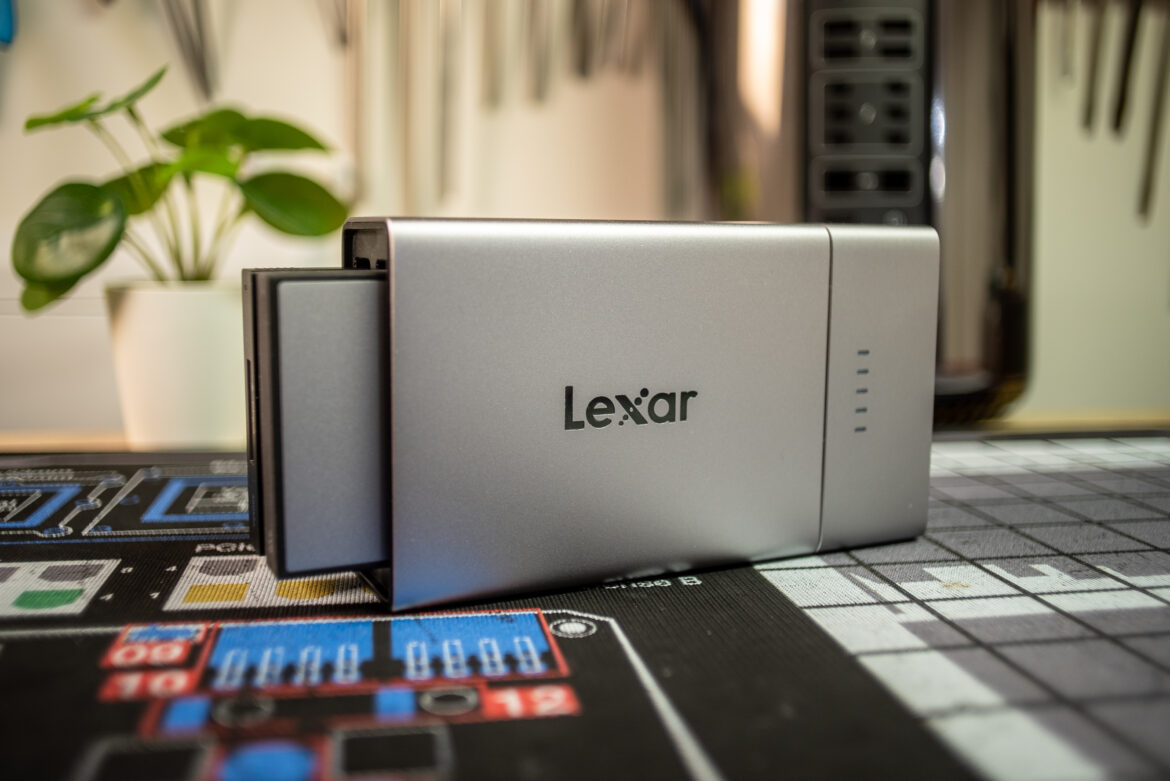We review the Lexar Professional Workflow Go, rugged 4TB SSD, and CFexpress Type A reader—modular storage tools for content creators.
The Lexar Professional Workflow ecosystem is a collection of products designed to offer creative professionals a modular system for offloading, transferring, and storing data. The Workflow line includes four card readers that read CFexpress Type A and B and UHS-II SD and microSD cards. The line features a 6-bay Thunderbolt docking station, ruggedized portable SSDs, and the battery-powered, 2-bay Workflow Go dock.
Today, we will be looking specifically at the Workflow Go, the 4TB Workflow SSD, and the CFexpress Type A reader, while considering the ecosystem as a whole. We did a separate review if you want to read more about the SD cards and readers.
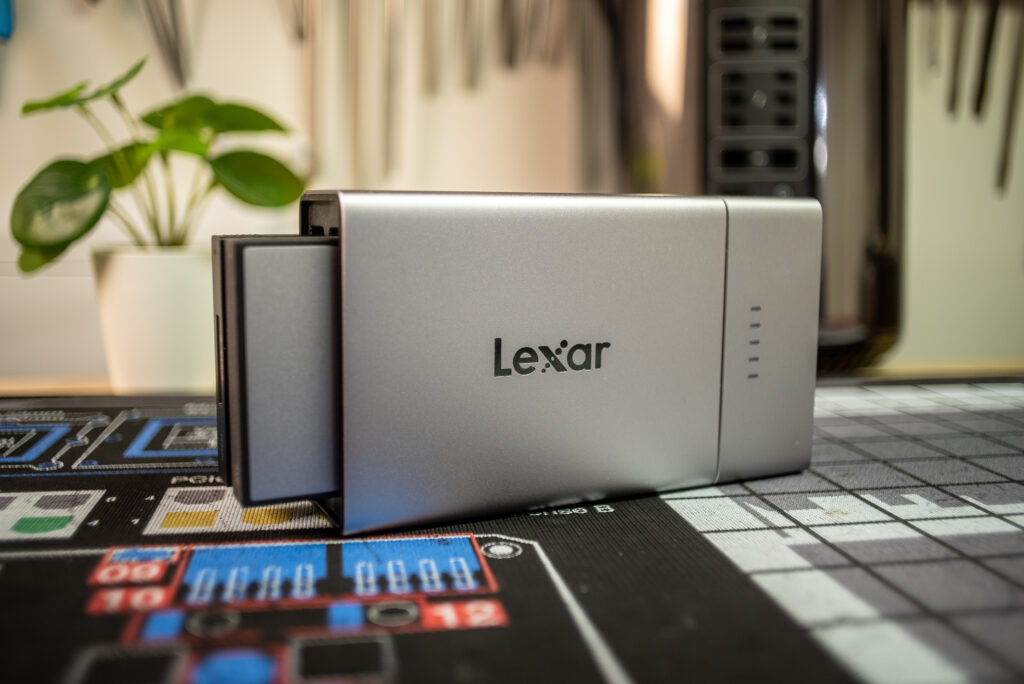
Lexar Professional Workflow Specifications
Let’s look at the specs for the modules and dock we’re reviewing here. Some of them are pretty cool, and some are real head-scratchers; more on that later. Generally, everything connects to everything else via USB-C, and all the modules can be used independently of the dock. The dock’s battery can also be separated to power other devices.
| Workflow Portable SSD | |
| Available Capacities | 2TB, 4TB |
| External Interface | USB 3.2 Gen 2×2 (20Gbps) |
| Ingress Protection: | IP68 (Dust-proof, Waterproof 1.5m up to 30 minutes) |
| Dimensions (L x W x H) | 4.07in x 2.27in x 0.47in (103.4mm x 57.7mm x 12.0mm) |
| Weight | 145g (0.32lbs) |
| Warranty | 5-Year Warranty |
| Workflow CFexpress 4.0 Type A | |
| External Interface | USB 4.0 (40Gbps) |
| Dimensions (L x W x H) | 4.07in x 2.27in x 0.47in (103.4mm x 57.7mm x 12.0mm) |
| Weight | 84g (0.19lbs) |
| Warranty | 3-Year Warranty |
| Workflow Go | |
| Module Capacity | 2-bay |
| External and Internal Interface | USB 3.2 Gen2 (10Gbps) |
| Battery | 5000mAh, 5V 3A – 12V⎓1.67A |
| Dimensions (L x W x H) | 5.35in x 3.03in x 1.49in (136 x 77 x 38mm) |
| Weight | 318g (0.7lbs) |
| Warranty | 2-Year Warranty< |
Lexar Professional Workflow Design and Build
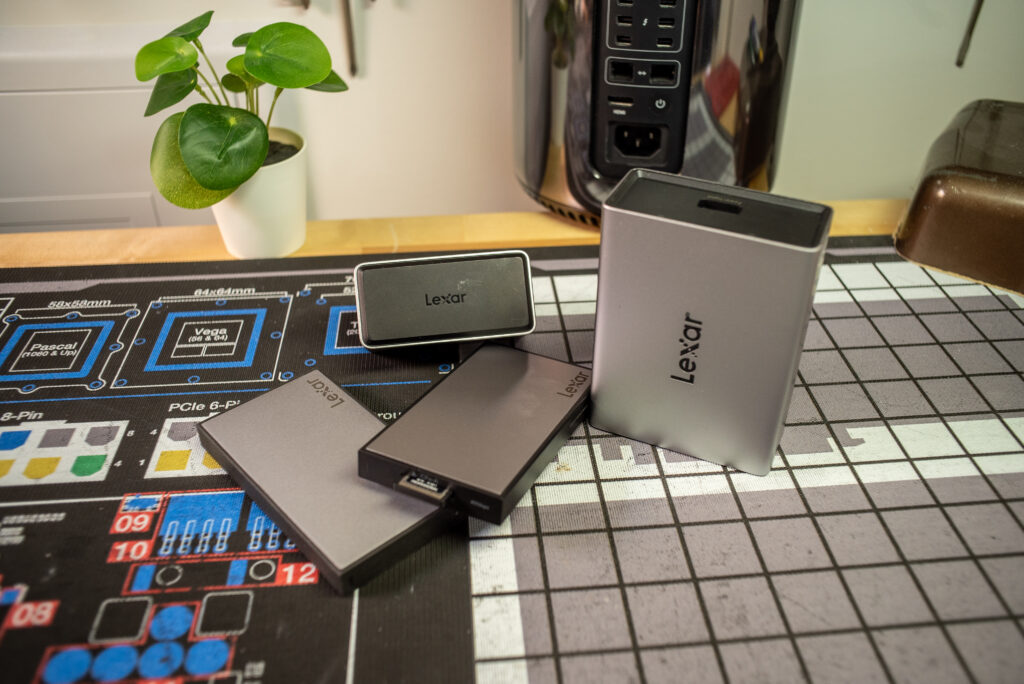 The Lexar Professional Workflow lineup all follows a pretty similar design language. Most modules are encased in aluminum with plastic edges to enhance their high-rated shock resistance. The aluminum also helps the SSD with heat dissipation, and it trades plastic edges for rubber ones to provide an IP68 rating.
The Lexar Professional Workflow lineup all follows a pretty similar design language. Most modules are encased in aluminum with plastic edges to enhance their high-rated shock resistance. The aluminum also helps the SSD with heat dissipation, and it trades plastic edges for rubber ones to provide an IP68 rating.
The Workflow Go portable dock is also mostly aluminum; however, there are soft-touch plastic parts that are easily marred. The spring-loaded doors of the bays are a nice touch to keep dust and debris out of unused slots. There’s a bit of wiggle in the modules when installed in the dock, but overall it feels secure. The battery is held in place with magnets that don’t inspire confidence, but may only prove problematic to the clumsier among us. We don’t have the large dock to comment on its build quality.
From a repairability standpoint, it’s a mixed bag. Overall, the fact that the system is modular is inherently positive, as it does not throw the baby out with the bathwater if a component breaks. However, the readers are completely held together with glue, and the portable dock and battery have no visible fasteners, which means they all become e-waste when they break. The battery especially seems like it would be difficult, if not impossible, to re-cell when it can no longer hold a charge.
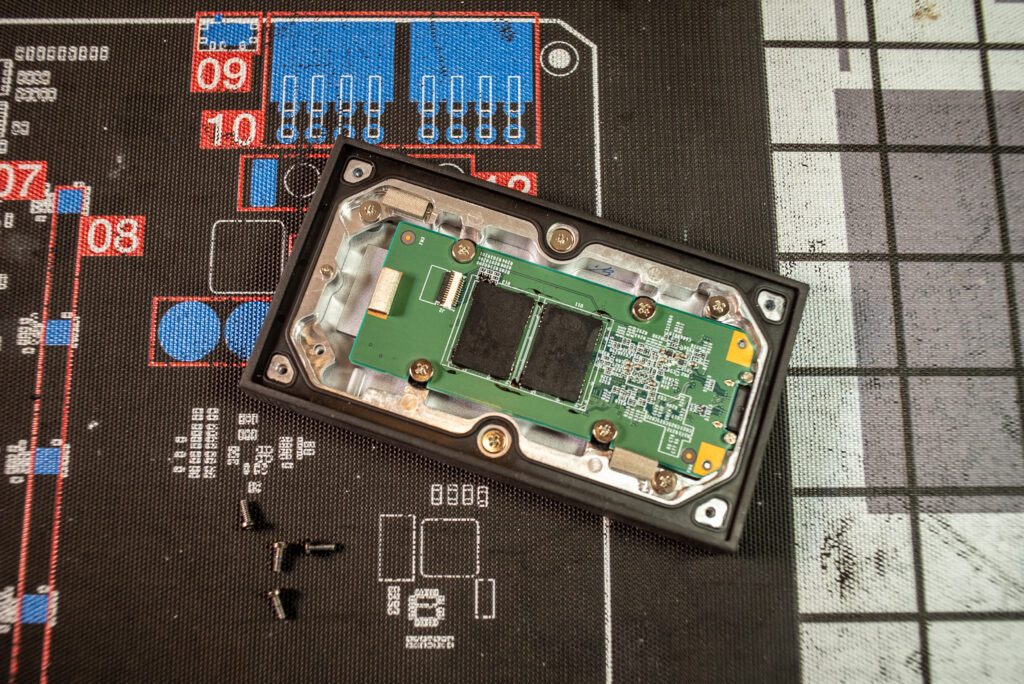 On a positive note, the SSD is easily accessible with four Torx screws, allowing access to the honestly kind of beautiful insides. The aluminum case shows its CNC marks inside, with the rubber gasket surrounding it, with Phillips screws holding everything in. Unfortunately, the SSD seems to be a proprietary form factor to fit within the module’s size. It has NAND modules made by Longsys, Lexar’s parent company. I do want other manufacturers to take note here; you can create a portable SSD with good ingress protection without completely sealing it with adhesive.
On a positive note, the SSD is easily accessible with four Torx screws, allowing access to the honestly kind of beautiful insides. The aluminum case shows its CNC marks inside, with the rubber gasket surrounding it, with Phillips screws holding everything in. Unfortunately, the SSD seems to be a proprietary form factor to fit within the module’s size. It has NAND modules made by Longsys, Lexar’s parent company. I do want other manufacturers to take note here; you can create a portable SSD with good ingress protection without completely sealing it with adhesive.
Workflow Docks and Modules
Lexar offers a somewhat limited, but still adequate, lineup of modules for its Workflow ecosystem. I mentioned them in the intro, but let’s look more in-depth. Starting with the docks, the big boy is the 6-bay docking station. This dock has two Thunderbolt 4 bays (40Gbps) and four USB-C bays (10Gbps), additional USB ports, Thunderbolt passthrough for daisy-chaining, and a 140W charger. It’s the most expensive piece of the ecosystem at $550 with no modules. You could, in theory, fill it with six 4TB SSDs and RAID them in software, which is just the kind of crazy we like to see. I couldn’t get the company card in time to charge the ~$3,200 that endeavor would cost, but more on price later.
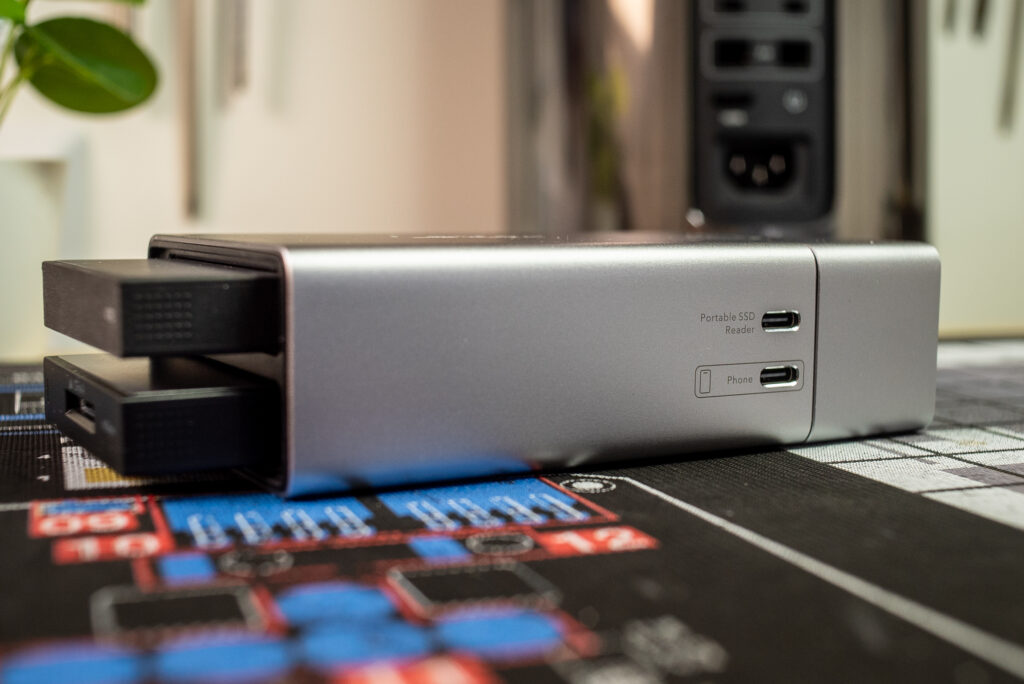
The Workflow Go is a 2-bay portable dock with a 5000mAh battery that can be separated and used to charge other devices. While the battery doesn’t support specs like Qualcomm QC or USB-PD, it has multi-voltage support and can provide enough juice to your mobile devices to top them up in a reasonable amount of time. Lexar rates it for about 4.5 hours when used with the dock. The rest of the device is ostensibly a glorified USB-C dock, but that’s not a bad thing. It has 10Gbps connections for all the data ports, with one upstream connection and an extra USB-C port for additional drives. This is intended to be used with a phone app, but in my testing, it works considerably better with a computer; more on that later. It can also work without the battery on devices that supply bus power, or with a USB-C wall charger if you need additional juice on that extra port.
The types of card readers are somewhat limited, but Lexar covers the essentials. There are two flavors of SD card reader, one with two full-size SD slots and one with a microSD and SD slot, both supporting UHS-II and USB 3.2 Gen2 (10Gbps). The other two readers are for CFexpress Type A or B cards. These single-slot readers support USB 4.0 (40Gbps), which lets you take advantage of CFexpress’s high speeds. Having a CFast or CF reader would be nice, but those are old technologies at this point, so their omission is not surprising.
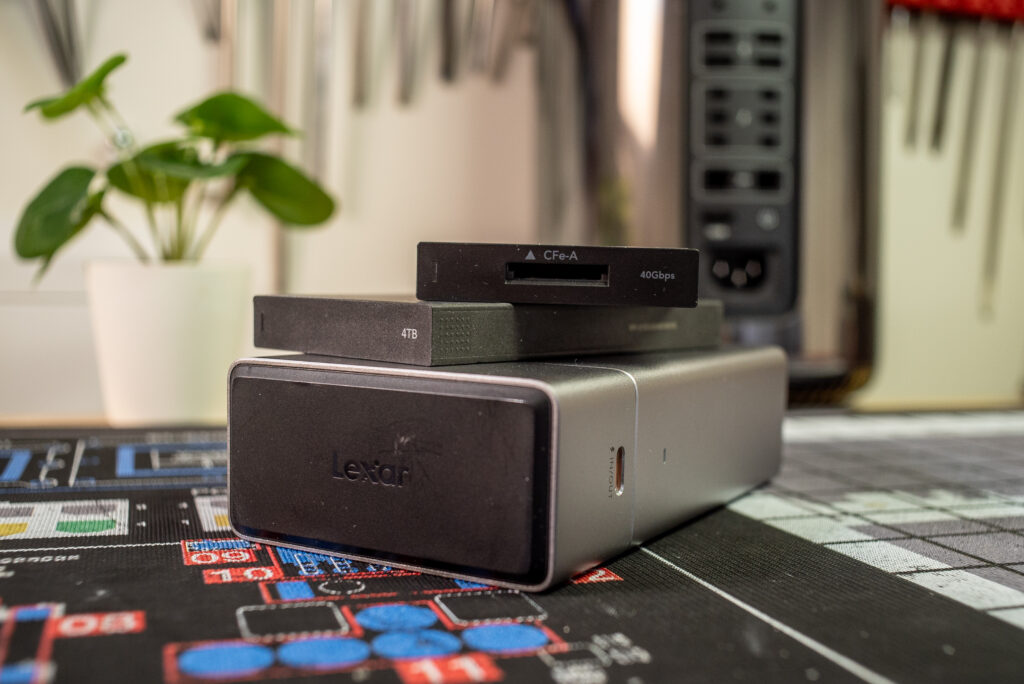
The Workflow SSDs come in two capacities, 2TB and 4TB, leveraging USB-C Gen 2×2 (20Gbps). Earlier, when I said that some specs are head scratchers, I was referring to this interface choice. In the creative professional world, macOS is ubiquitous, and no Macs support 2×2. Obviously, other systems support this spec, but the real head-scratcher here is that none of the docks support it. Even the big Thunderbolt-based dock only supports 10Gbps speeds with the SSD. The only way to get the full speed out of this drive is to use it independently of the Workflow ecosystem it was designed for, on a system that supports 2×2. What an odd design decision.
Performance
Changing gears a bit, let’s take a look at performance. I’ll be testing the 4TB SSD and the CFexpress Type A reader, both in and out of the Workflow Go dock. Let’s start with the SSD. This drive leverages USB 3.2 Gen 2×2 with a claimed speed of 2,000MB/s read and write. Unfortunately, I do not have a system with 2×2 to test full-speed claims. The following results are based on a single lane USB (10 Gbps) connection or Thunderbolt 4 connection on an M1 Max MacBook Pro 16″.
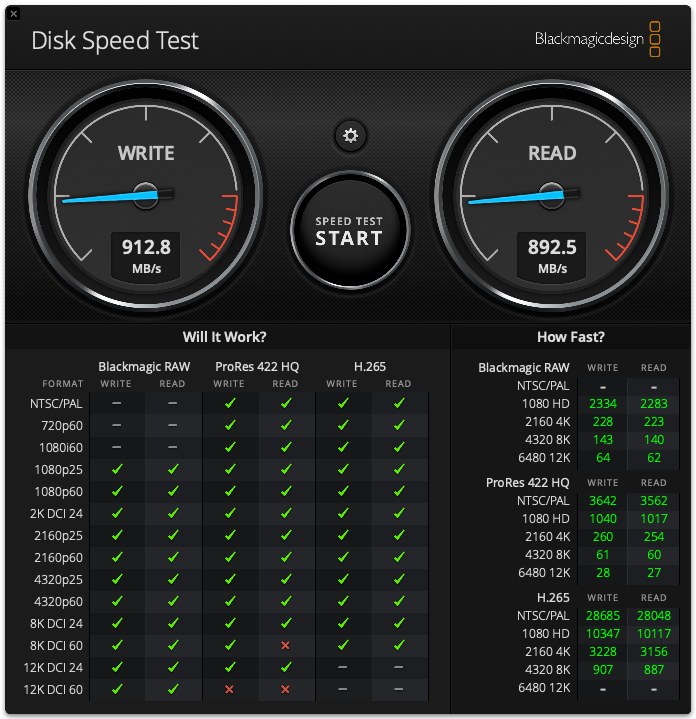
In the Blackmagic Disk Speed Test, the Lexar Professional Workflow SSD saw read and write speeds of around 900MB/s. It performed the same in and out of the Workflow Go dock. As mentioned before, though, the Workflow Go dock is limited to 10Gbps while the SSD is capable of 20Gbps on a compatible system. Blackmagic doesn’t always tell the whole story and undersells performance on most drives.
 In ATTO Disk Benchmark, the picture becomes much clearer. We fully saturate the 10Gbps connection, reaching just over 1,000 MB/s read, and just under that for writes. This drive also performs very well at smaller file sizes, reading about 600 MB/s at 16KiB, which will matter for photographers whose offloads tend to involve plenty of smaller files. The video folks will not be disappointed, though, as the large file sequential is also quite performant. While there are no 2×2 benchmarks, I have no reason to believe this drive won’t live up to Lexar’s claims.
In ATTO Disk Benchmark, the picture becomes much clearer. We fully saturate the 10Gbps connection, reaching just over 1,000 MB/s read, and just under that for writes. This drive also performs very well at smaller file sizes, reading about 600 MB/s at 16KiB, which will matter for photographers whose offloads tend to involve plenty of smaller files. The video folks will not be disappointed, though, as the large file sequential is also quite performant. While there are no 2×2 benchmarks, I have no reason to believe this drive won’t live up to Lexar’s claims.
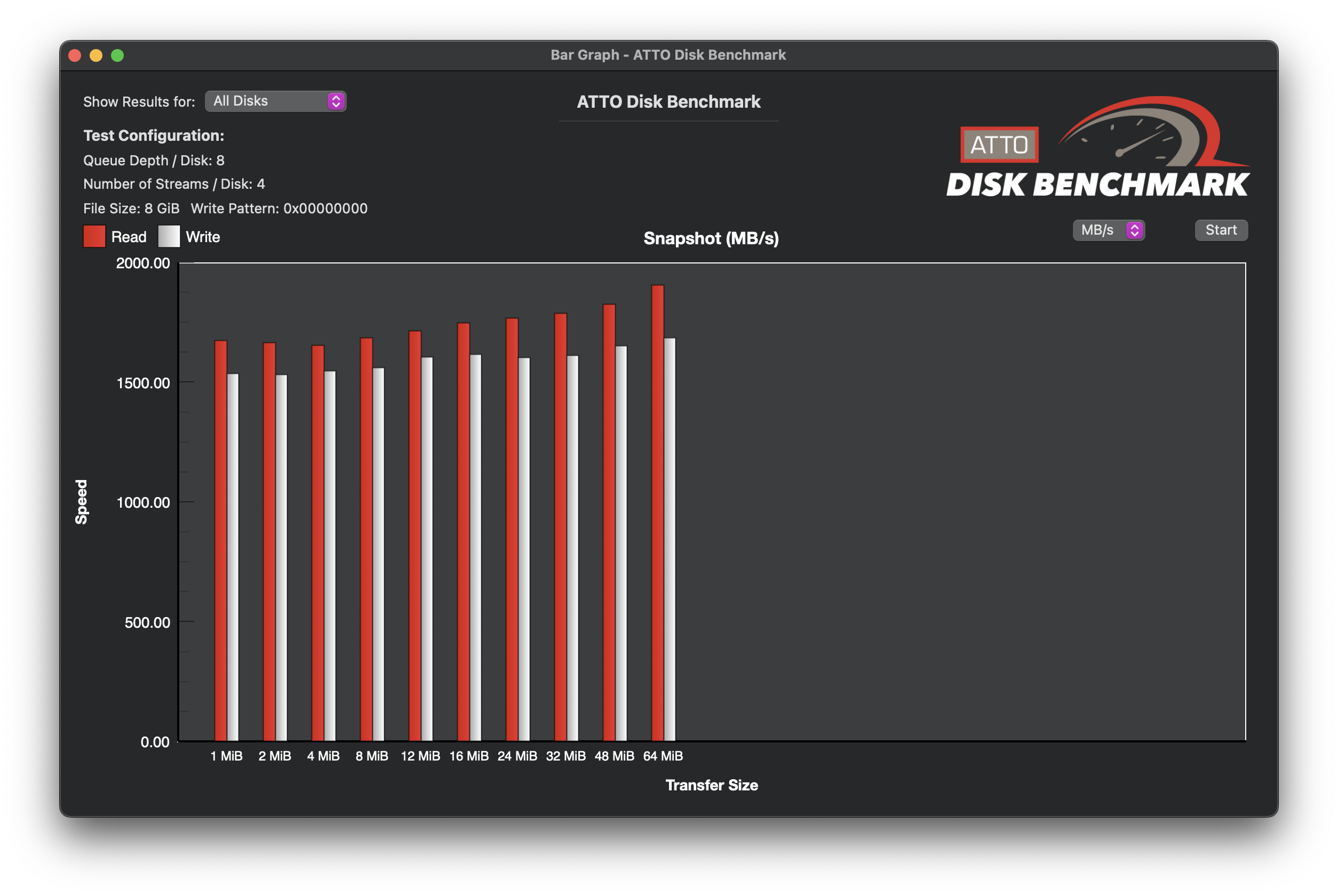
Looking at the CFexpress Type A reader, I used Lexar’s 1TB CFexpress Type A card for this test. Using ATTO Disk Benchmark again, the reader sees about 853 MB/s read and 836 MB/s write in the Workflow Go dock. Once freed and connected to a Thunderbolt 4 port, we see much better performance with 1,906 MB/s read and 1,684 MB/s write. This exceeds the rated 1,850 MB/s read and 1,650MB/s write of the card, and either speed will be more than enough for video professionals.
Conclusion
I haven’t mentioned it yet, so now’s a good time to mention the Lexar app the Workflow Go was intended for. It’s not great. The idea is that you can offload a card to the SSD using your phone and this app, eliminating the need for a computer. In practice, it’s cumbersome and requires you to leave the app open and awake, or else the transfer fails. The app offers checksum verification, which is nice but moot considering its other shortcomings. It relies on your phone’s USB-C capabilities for transfer speeds, and most devices, even if they’re USB 3, will not offer any decent performance. Considering the slowest speed you can get in this dock is over 1,000MB/s, being limited by your phone’s USB port feels bad.
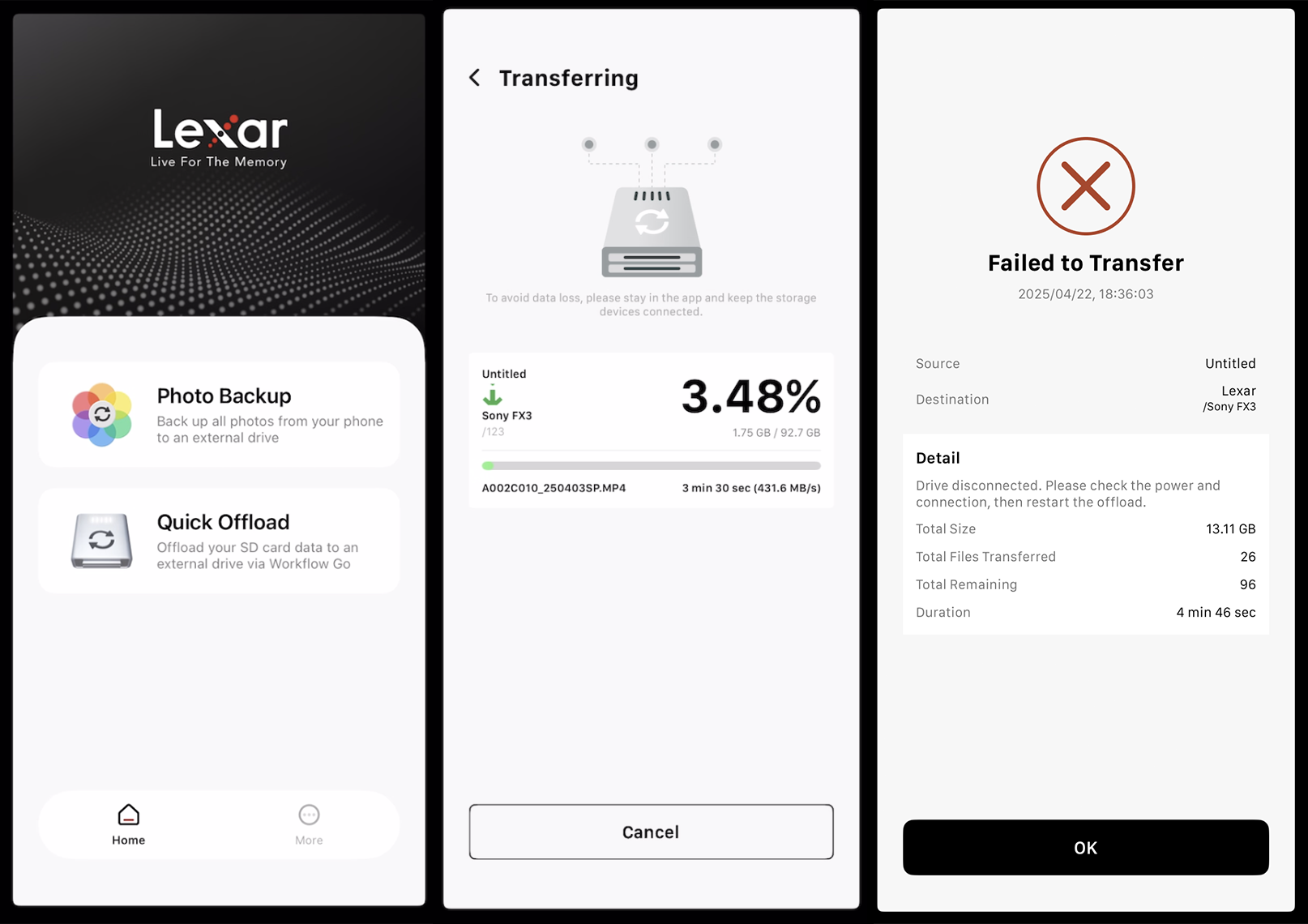
The app itself is also just a fancy-looking file browser. As mentioned, the Workflow Go is ostensibly just a USB-C hub, which means it just appears as external storage to any device it’s plugged into. More importantly, it will work with any computer, where the value proposition changes. I had originally been pessimistic about this product’s viability, but after realizing it’s just a battery-powered hub, the use cases expanded and its usefulness increased.
I haven’t mentioned the price yet, so let’s discuss that. Most Lexar Professional Workflow system items are a little expensive or in line with the rest of the market. The notable exception is the SSDs; at the time of writing, they come in at $450 for the 4TB and $270 for the 2TB model (affiliate link), which is steep considering what the competition offers. A 4TB SSD from a reputable brand capable of 1,000 MB/s can be had for practically half the price. If you insist on USB 3.2 Gen 2×2, you can get a 4TB Samsung T9 for $299, and if you insist on both USB 3.2 Gen 2×2 and ruggedness, LaCie has you covered with their familiar orange rubber drives for $349. Even Lexar’s own ruggedized 4TB SSD is also only $349.
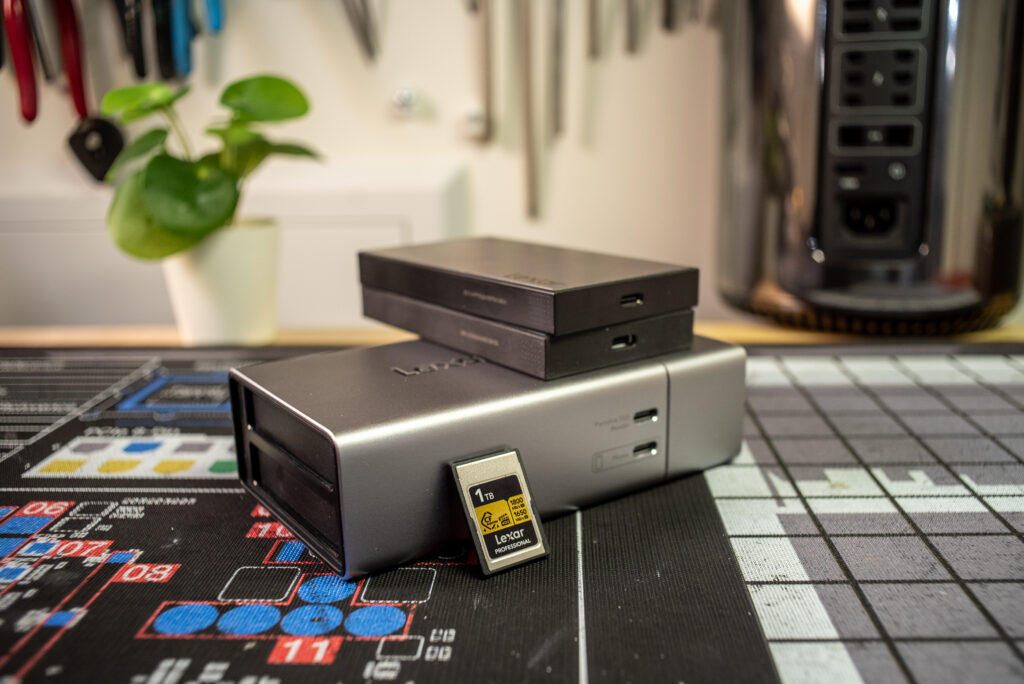
Okay, but what about the rest of the lineup? The CFexpress readers come in at $90 each, which is not the cheapest, but fairly in line with other readers that offer this kind of speed. The SD card readers are $45 each, which again is not cheap, but not expensive either. As mentioned, the full-sized 6-bay dock weighs in at $550, and the portable Workflow Go can be had for just $90. The Workflow Go has the highest value, in my opinion, since it offers some uses outside its intended use case, as I’ve talked about.
I can recommend the portable dock and the 40Gbps card readers with ease. I cannot, however, recommend the SSD. There’s nothing wrong with the drives; in fact, they’re good and offer ruggedization, but they’re just too expensive right now. I hope to see the price come down to be more in line with the rest of the market; I mean, I’d even like to see it be more in line with Lexar’s own products. If the price were lower, it would be an easy recommendation, and the small premium to buy into the ecosystem would be well worth it.
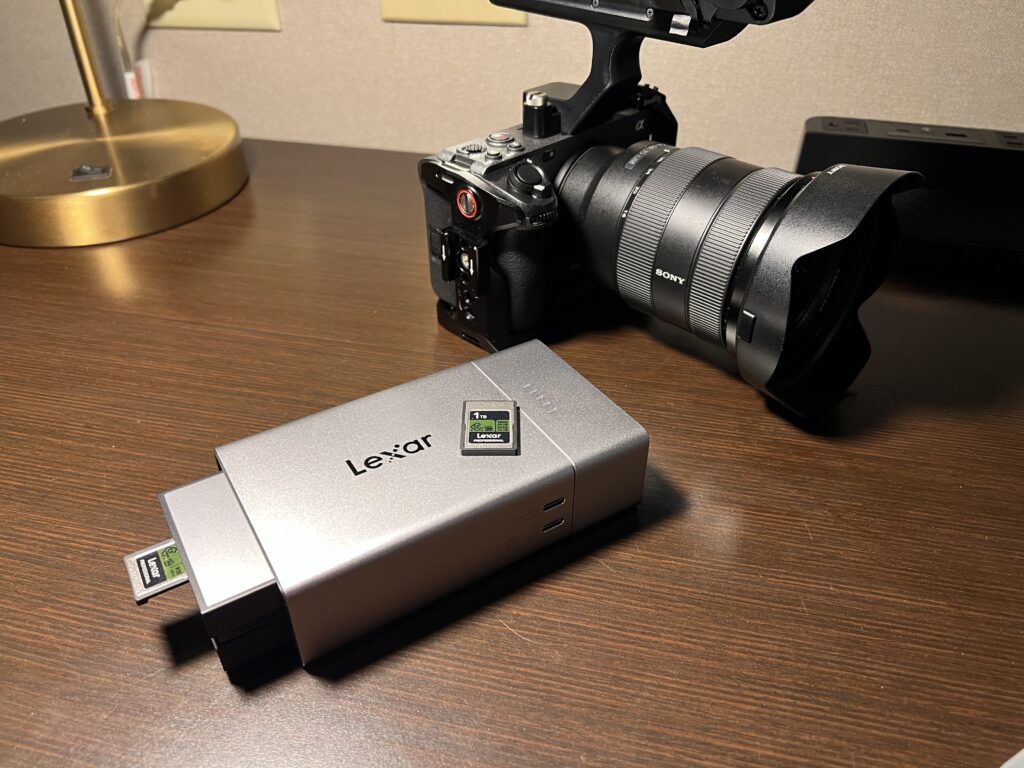
Overall, I’ve grown to quite like the Lexar Professional Workflow ecosystem. The Workflow Go specifically has grown on me, and I often use it on travel jobs, even if I’m using it with my computer and not their app. I used it on our recent trip to DC with no issues. The form factor is good, and while it may seem insignificant, the USB hub functionality saves me from having to bring a dock and a separate battery bank. All that in one package is pretty neat. So while I don’t give the whole Workflow line a full recommendation right now, I would set up price tracking on those SSDs and seriously consider the Workflow system once those come down in price.
Lexar Workflow at Amazon (affiliate link)
Engage with StorageReview
Newsletter | YouTube | Podcast iTunes/Spotify | Instagram | Twitter | TikTok | RSS Feed

